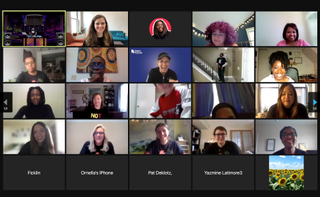Students from across the U.S. recently gathered virtually to promote student voice in education at the first annual Students for Equitable Education Summit: Moving From Advocacy to Action.
The summit was spearheaded by superintendents Marlon J. Styles Jr. from Middletown City School District in Ohio and Julie Mitchell from Rowland USD in California, and launched in collaboration with The Digital Promise League of Innovative Schools. It brought together more than 50 student leaders to share their insights with the 1,000+ educators in attendance.
Participants shared takeaways from the experience, offering advice and best practices.
1. Teachers Are Learners, Too
“I am a transgender student and there’s a lot of things I wish my teachers would have done, and I know other people wish their teachers would have done,” says Brooks Wisniewski, a former student at Kettle Moraine School for Arts and Performance and current student at Interlochen Arts Academy in Michigan. He adds that sometimes teachers engage in exclusionary practices without realizing it.
For instance, the simple act of going around the class and introducing students to one another can be tweaked to be inclusive. “When everybody's sharing out at the beginning of the school year, everybody just says their name and grade,” Wisniewski says. “I would always say my pronouns, because people may assume I have different pronouns than I identify with.”
Wisniewski urges teachers to realize that they are learning as much as they are teaching. “Students can have great ideas sometimes,” he says. “If I were to come up to my teacher, and be like, ‘Hey, I would appreciate it if you use pronouns.’ The idea is that they're open to that.”
2. School is About More Than School Work
Students are taught math, English, biology, and other subjects while at school, but the education experience often goes deeper. “We're not learning about school subjects and school subjects only, we’re learning about life,” says Andrea J Dela Victoria, a recent grad of Rowland Unified School District. “When you're in the classroom, you want to have real conversations with your students in order to open up that productive learning environment.”
To get students to open up in these conversations, educators typically need to start the discussion, says Mitchell, one of the educators who helped plan the summit. For example, she says that in early planning meetings for the summit, students were reluctant to speak at first. “They weren’t able to really share and to be vulnerable with us until we were being vulnerable,” Mitchell says.
3. Difficult Conversations Are a Must-Have
It’s not enough to just make time for conversations, educators need to keep the dialogue going even -- and especially -- when it goes down uncomfortable avenues. “Sometimes for change to actually happen you have to have awkward, or difficult conversations,” says Ikponmwosa Agho, a recent graduate from Richland School District Two in South Carolina.
These challenging moments allow deeper conversations to develop, adds Victoria. “In a conversation, everyone fears that awkward silence, but awkward silence is okay,” she says. “It might just give students the time to really think about that question, to think about their response to reflect on what this conversation is truly about, not just that quick response.”
4. Challenge Existing Norms and Make Time for Students
“A lot of what this summit was doing was challenging teachers,” says Noor Salameh, a student at Kettle Moraine School District in Wisconsin. “I encourage teachers to challenge authority. America has a public school system that has been teaching most of the same curriculum for decades now. But the world is evolving and it's changing, and challenging that curriculum and bringing that to your superintendents, your school board, that's how we get things done, instead of just complying with an education system that's a little bit outdated.”
To better understand what students' feelings are, Mitchell recommends that her fellow educators set aside time to get to know students and ask follow-up questions to clarify their concerns, wishes, and ideas.
Educators also need to do all this without putting the student or their thoughts and ideas on trial. “One hundred percent you must set aside judgment,” she says.


